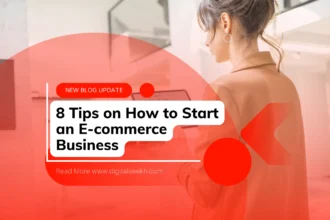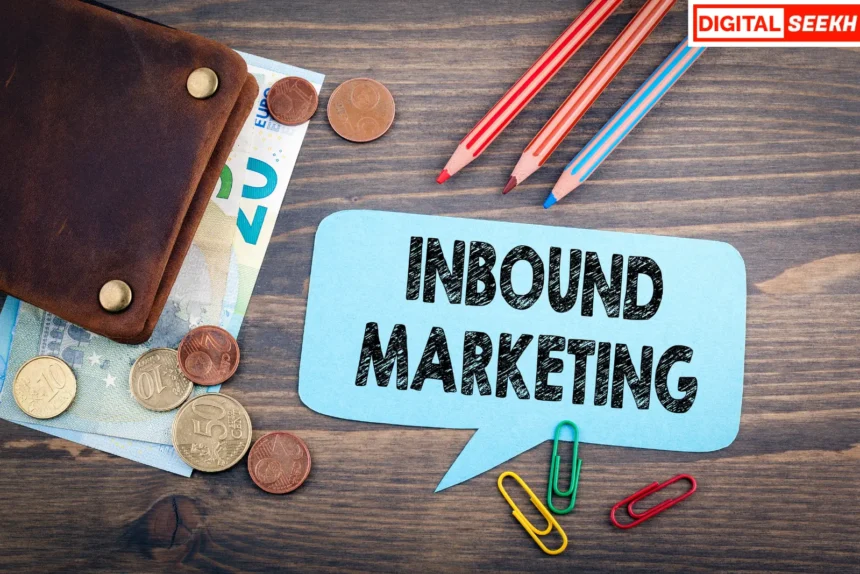As a digital marketer or content creator, you’re probably already aware of the power of inbound marketing. But have you considered the role that social media plays in this strategy? In today’s digital age, social media has become an integral part of any successful inbound marketing campaign. It allows businesses to connect with their audience, build brand awareness, and drive traffic to their website.
We will discuss the significance of social media in this context and how businesses can leverage different platforms to increase brand awareness, engage with customers, and generate leads.
This article will explore the relationship between social media and inbound marketing, sharing best practices and tips for utilizing social media effectively in your marketing efforts.
What is Inbound Marketing?
Inbound marketing is a customer-centric approach to digital marketing that focuses on attracting customers through content sharing, personalized interactions, and targeted audience engagement.
By prioritizing customer needs and interests, inbound marketing aims to build trust and establish long-lasting relationships. In today’s digital landscape, where consumers are constantly bombarded with advertising messages, providing valuable and relevant content is crucial for standing out.
Through effective lead generation strategies, businesses can capture the attention of potential customers and nurture them into loyal followers. By leveraging various channels such as social media, email marketing, and SEO, companies can reach a wider audience and drive engagement.
Audience targeting plays a pivotal role in maximizing the effectiveness of inbound marketing efforts by tailoring content to specific demographics, behaviors, and interests.
What is Social Media?
Social media refers to online platforms that enable social networking, brand promotion, and interaction with a wide audience, enhancing brand awareness and establishing a strong online presence.
These platforms have transformed the way individuals and businesses communicate, allowing them to reach out to potential customers globally with ease. Through social media, brands can engage directly with their audience, creating a sense of community and trust. The interactive nature of social media encourages two-way communication, enabling businesses to receive real-time feedback and insights that can be used to refine marketing strategies. By actively participating in conversations on social media, brands can humanize their image, making them more relatable and trustworthy to their target audience.
How are Inbound Marketing and Social Media Connected?
Inbound marketing and social media are intricately connected in building customer engagement, enhancing brand reputation, and driving lead generation through targeted interactions and content sharing.
By leveraging social platforms effectively, businesses can tap into a vast network of potential customers and create meaningful connections. Social media provides a platform for brands to interact directly with their audience, addressing their concerns, sharing valuable content, and showcasing their expertise. Through active engagement on platforms like Facebook, Twitter, LinkedIn, and Instagram, companies can stay top-of-mind with their followers and encourage them to take desired actions, such as signing up for newsletters, downloading resources, or making a purchase.
Creating Brand Awareness
Creating brand awareness through social media involves leveraging various platforms to target specific audiences and increase brand visibility, establishing a strong digital presence.
- Engaging content plays a key role in capturing audience attention and fostering brand loyalty. By creating relevant and valuable content that resonates with the target audience, brands can establish themselves as industry leaders and build credibility.
- Active participation on social media platforms such as Instagram, Facebook, Twitter, and LinkedIn allows brands to directly interact with consumers, respond to queries, and address concerns, thus humanizing the brand and fostering a sense of community.
- Consistent posting schedules, utilizing hashtags strategically, and collaborating with influencers are effective strategies to enhance brand visibility and attract new followers.
Building Relationships with Customers
Building relationships with customers via social media is essential for fostering trust, loyalty, and long-term engagement, creating a strong foundation for brand advocacy.
Interacting with customers through social media allows brands to humanize their image and connect with their audience on a personal level, which is crucial for building lasting relationships.
By responding promptly to customer inquiries, addressing concerns, and providing valuable insights, businesses can demonstrate their commitment to customer satisfaction and establish credibility.
Consistent engagement on social platforms not only helps in retaining existing customers but also attracts new ones, as satisfied customers are more likely to share their positive experiences with others, thus contributing to brand advocacy and growth.
Strong brand-customer relationships are built on a foundation of trust, which can be nurtured through genuine interactions and a customer-centric approach.
Driving Website Traffic
Driving website traffic through social media channels boosts online presence, enhances SEO benefits, and increases visibility through content sharing and social interactions.
By utilizing various social media platforms such as Facebook, Twitter, Instagram, and LinkedIn, businesses can reach a wider audience and drive targeted traffic to their websites. Social sharing not only promotes brand awareness but also plays a crucial role in improving search engine rankings. When users engage with and share content, it signals to search engines that the content is valuable, leading to higher visibility and improved SEO performance.
To optimize for increased traffic, creating shareable and engaging content tailored to each platform’s audience preferences is key.
Generating Leads
Generating leads via social media involves targeted audience outreach, optimizing conversion rates, and implementing inbound strategies to capture and nurture potential customers.
- One effective technique for audience targeting is utilizing the advertising features offered on social media platforms. By leveraging tools like custom audience segmentation and lookalike audience creation, businesses can hone in on individuals who are more likely to be interested in their products or services.
- To boost conversion rates, businesses can employ tactics such as creating compelling content that resonates with their audience or using interactive elements like quizzes and polls to engage users.
- Applying inbound marketing principles means providing valuable and relevant information to prospects, building trust and credibility before attempting to sell.
By aligning content with the buyer’s journey, businesses can attract, convert, close, and delight potential leads more effectively.
Improving Customer Engagement
Enhancing customer engagement through social media involves fostering user interactions, engaging with the audience, and prioritizing customer satisfaction to build long-lasting relationships.
By actively responding to comments, messages, and mentions, brands can create a sense of community and personalized connection with their audience. Encouraging user-generated content through contests, challenges, or polls can further enhance engagement levels. Consistent and authentic communication is key to establishing trust and loyalty among customers.
Implementing data analytics to understand customer behavior and preferences allows businesses to tailor their content and offerings effectively, leading to increased engagement. A well-rounded approach that puts customer satisfaction at the forefront can significantly impact brand loyalty and long-term success on social platforms.
What are the Benefits of Using Social Media for Inbound Marketing?
Utilizing social media for inbound marketing offers a myriad of benefits, including enhanced ROI, valuable customer insights, and improved marketing effectiveness through targeted engagements.
By seamlessly integrating social media platforms like Facebook, Instagram, and Twitter into your inbound marketing strategies, you can tap into a vast pool of potential customers who are actively engaging with content in these spaces. The interactive nature of social media allows for real-time interactions and feedback, giving businesses the opportunity to tailor their messages to specific target audiences. This level of personalization not only enhances customer engagement but also fosters brand loyalty and trust, ultimately leading to conversions and an increase in revenue generation.
Cost-effective Marketing Strategy
Social media serves as a cost-effective marketing strategy by offering extensive marketing reach, targeted advertising options, and versatile tactics to maximize campaign effectiveness.
It allows businesses to connect with a widespread audience across various demographics, enabling them to tailor their message to specific consumer groups. By leveraging online platforms, companies can run highly targeted ad campaigns that reach their ideal customers at a fraction of the cost compared to traditional advertising methods. With the ability to track performance metrics in real-time, organizations can efficiently optimize their marketing efforts for increased engagement and conversions. By actively engaging with followers and leveraging user-generated content, companies can foster a sense of community and loyalty, further amplifying their brand message.
Targeted Audience Reach
Social media enables targeted audience reach through strategic audience profiling, customized content strategies, and interactive brand engagement tactics to connect with the right demographic.
By analyzing data such as demographics, interests, and behavior patterns, businesses can tailor their content to resonate with specific audience segments. Utilizing social media analytics tools, companies can track engagement metrics to gain insights on what their target audience responds to best. Crafting personalized messaging for different demographics, such as millennials or working professionals, can enhance brand relevance and increase audience connection. Engaging with followers through interactive posts, polls, and live sessions fosters a sense of community and loyalty, further solidifying the relationship between the brand and its audience.
Improved Customer Insights
Social media facilitates improved customer insights by enabling real-time feedback, in-depth market research, and analysis of customer behavior patterns for data-driven decision-making.
This direct interaction with customers allows businesses to gain valuable feedback on products and services, identify emerging trends, and address any issues promptly.
Market research conducted on social platforms provides a wealth of information on consumer preferences, purchasing behavior, and competitors’ strategies.
By analyzing customer behavior trends on social media, companies can not only understand their target audience better but also predict future trends and adapt their marketing strategies accordingly.
Data analysis plays a crucial role in deciphering customer preferences, sentiments, and engagement levels, enabling businesses to tailor their offerings for maximum impact.
Increased Brand Authority and Credibility
Social media contributes to increased brand authority and credibility through enhanced brand visibility, positive brand reputation, and social proof elements that validate a brand’s authenticity and reliability.
Engaging with followers in a meaningful way plays a crucial role in establishing brand authority. By providing valuable content that resonates with the target audience, brands can build trust and credibility.
Consistent interaction with followers, prompt responses to queries and feedback, and showcasing customer testimonials are effective strategies to boost brand visibility and reputation. Leveraging user-generated content and influencer partnerships can further enhance a brand’s social proof, showcasing real-life experiences that validate the brand’s credibility in the eyes of the audience.
Higher Conversion Rates
Social media drives higher conversion rates by optimizing lead conversion strategies, facilitating customer acquisition, nurturing leads effectively, and fostering customer retention through engaging interactions.
The impact of social media on conversion rates extends beyond immediate transactions, as it opens up a gateway for businesses to connect with their audience on a more personal level. By leveraging social platforms, companies can employ various lead conversion tactics such as targeted advertising, interactive content, and personalized messaging to guide potential customers through the sales funnel. This personalized approach not only enhances customer acquisition but also boosts brand credibility and loyalty. Effective lead nurturing strategies on social media involve providing valuable insights, responding promptly to inquiries, and delivering tailored content to keep prospects engaged.
What are the Best Social Media Platforms for Inbound Marketing?
Selecting the best social media platforms for inbound marketing involves considering factors such as influencer reach, content distribution capabilities, and alignment with brand messaging strategies.
- When it comes to influencer marketing, it is essential to evaluate how well the platform harnesses the power of key opinion leaders to engage with the target audience. Platforms like Instagram and TikTok, known for their influencer culture, can be ideal for brands aiming to leverage influencer collaborations effectively.
- Focusing on content distribution mechanisms is crucial for maximizing visibility and engagement. Understanding the platform’s algorithm, features like hashtags, and sharing options can significantly impact the effectiveness of content in reaching the right audience. Maintaining consistency in brand messaging is essential in determining platform suitability. A platform that aligns well with a brand’s voice, values, and messaging style can enhance brand credibility and resonate better with the audience.
Facebook stands out as a versatile platform for online engagement, community building initiatives, and impactful brand engagement strategies that resonate with diverse audiences.
From business pages to groups and events, Facebook offers a myriad of tools to help brands connect with their target audiences. Companies can utilize interactive features such as polls, live videos, and messaging bots to create meaningful interactions with followers. The platform’s ability to facilitate discussions and nurture relationships paves the way for effective community building. By analyzing data insights and optimizing content for the Facebook algorithm, businesses can tailor their strategies for maximum visibility and engagement, driving success in inbound marketing efforts.
Instagram’s visual-centric approach offers unparalleled user engagement opportunities through compelling visual content, innovative engagement features, and creative content creation options for brands.
By focusing on high-quality visuals, businesses can stand out in the crowded platform and capture the attention of their target audience. Leveraging Instagram’s diverse array of filters, editing tools, and interactive features allows for enhanced storytelling and brand promotion. Incorporating user-generated content into a brand’s feed can foster a sense of community and authenticity, further boosting engagement. Using strategic hashtags, tagging relevant accounts, and participating in trending challenges are effective ways to increase visibility and reach on Instagram. Prioritizing visual storytelling is key to unlocking the full potential of brand engagement on the platform.
Twitter’s real-time interaction capabilities drive viral marketing potential, enhance content visibility, and offer immediate engagement opportunities for brands looking to amplify their online presence.
Engaging with audiences on Twitter allows brands to stay relevant in rapidly changing conversations, increasing the likelihood of their content going viral. By understanding the platform’s algorithms and utilizing trending hashtags, companies can strategically position their posts to reach a wider audience. Leveraging trending topics not only boosts brand visibility but also fosters a sense of connectedness with followers. The ability to respond quickly to current events and trends on Twitter can set brands apart and help them establish themselves as industry leaders.
LinkedIn’s focus on professional networking empowers lead generation efforts, facilitates industry trend analysis, and offers unique opportunities for B2B brands to expand their reach and influence.
By providing a platform where professionals can connect, share insights, and build relationships, LinkedIn fosters a conducive environment for businesses to tap into new leads and nurture existing connections. Leveraging tools like LinkedIn Sales Navigator and targeted advertising, businesses can implement lead generation strategies tailored to their specific target audience. The platform’s robust analytics make it easier to track industry trends, stay up-to-date with market changes, and adjust marketing approaches accordingly, ensuring that brands remain competitive and relevant in their respective industries.
YouTube
YouTube’s video-centric platform enhances brand visibility through engaging video content, fosters content sharing across diverse audiences, and provides a dynamic channel for brands to showcase their offerings.
By harnessing YouTube’s immense reach and user-friendly interface, brands can strategically create video content that resonates with their target audience. With the ability to tailor videos to specific demographics and interests, brands can effectively maximize their visibility and engagement levels. Leveraging YouTube for inbound marketing involves crafting compelling visual storytelling that not only captivates viewers but also drives them to take desired actions, such as visiting a website or making a purchase. By analyzing viewer data and trends, brands can refine their video strategies to consistently attract and retain a wider audience.
Also check – 14 Free Cutting-Edge AI Tools
Frequently Asked Questions
Why is Social Media an Important Part of Inbound Marketing?
Social media has become an essential part of inbound marketing strategies. It is a powerful tool that can help businesses reach and engage with their target audience. Here are some frequently asked questions about the importance of social media in inbound marketing.
How does social media contribute to inbound marketing?
Social media allows for two-way communication between businesses and their audience, making it a key aspect of inbound marketing. It helps attract, engage, and delight potential customers with valuable content and interactions that can eventually lead to conversions.
What makes social media an effective inbound marketing channel?
Social media platforms have a vast user base, making it an ideal channel for businesses to reach their target audience. It also offers various targeting options, allowing businesses to tailor their content to specific groups of people and increase the chances of conversion.
Can social media increase website traffic?
Yes, social media can drive traffic to your website by sharing links to your content and promotions. It can also improve your website’s search engine ranking through social signals, such as likes, shares, and comments.
How does social media help with customer engagement?
Social media allows businesses to interact with their customers in real-time, providing a more personalized and human touch to the brand. By responding to comments and messages, businesses can build stronger relationships with their customers and foster a sense of loyalty.
What role does social media play in creating brand awareness?
Social media is a powerful platform for brand awareness as it allows businesses to reach a large audience at a low cost. By consistently sharing valuable content and engaging with users, businesses can increase their brand visibility and attract potential customers.





